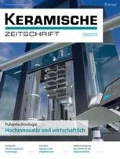Kurzfassung
Der Tintenstrahldruck gewinnt aufgrund seiner sehr hohen Flexibilität zunehmend an Bedeutung für die Verarbeitung funktioneller Materialien, beispielsweise im Bereich der gedruckten Elektronik. Allerdings fällt hierbei auf, dass in der Regel entweder partikelbasierte Tinten oder organische Tinten verarbeitet werden. Durch die Entwicklung einer Komposittinte aus Bariumstrontiumtitanat und Polymethylmethacrylat wird diese Lücke für gedruckte dielektrische Schichten geschlossen. Dies erlaubt eine vielversprechende Kombination der dielektrischen Eigenschaften sowie eine Verarbeitung auf flexiblen Substraten in einem einzelnen Prozessschritt.
Abstract
Inkjet printing offers a high flexibility and therefore is increasingly gaining importance for the selective deposition of functional materials, for example in printed electronics. However, till today either particle-based inks or inks based on organic molecules are used. This gap is now closed in the area of printed dielectric thick films by the use of a barium strontium titanate/poly(methyl methacrylate) composite ink. Such an ink allows a highly promising combination of the dielectric properties as well as a fabrication on flexible substrates in a single process step.
Literatur
Singh, M., Haverinen, H.M., Dhagat, P., Jabbour, G.E.: Inkjet Printing-Process and Its Applications. Advanced Materials 22 (2010) [6] 673–85
Cook, B.S., Cooper, J.R., Tentzeris, M.M.: Multi-Layer RF Capacitors on Flexible Substrates Utilizing Inkjet Printed Dielectric Polymers. IEEE Microwave and Wireless Components Letters 23 (2013) [7] 353–55
Friederich, A., Kohler, C., Nikfalazar, M., Wiens, A., Jakoby, R., Bauer, W., Binder, J.R.: Inkjet-Printed Metal-Insulator-Metal Capacitors for Tunable Microwave Applications. International Journal of Applied Ceramic Technology 12 (2015) [1] 164–173
Friederich, A., Binder, J.R., Bauer, W.: Rheological Control of the Coffee Stain Effect for Inkjet Printing of Ceramics. Journal of the American Ceramic Society 96 (2013) [7] 2093–99
Derby, B.: Inkjet printing ceramics: From drops to solid. Journal of the European Ceramic Society 31 (2011) [14] 2543–50
Mikolajek, M., Friederich, A., Kohler, C., Rosen, M., Rathjen, A., Krüger, K., Binder, J.R.: Direct Inkjet Printing of Dielectric Ceramic/Polymer Composite Thick Films. Advanced Engineering Materials 17 (2015) [9] 1294–1301
Author information
Authors and Affiliations
Corresponding author
Additional information
Morten Mikolajek studierte von 2007–2013 Wirtschaftschemie und Chemie mit Schwerpunkt Polymerchemie und Funktionsmaterialien an der Heinrich-Heine-Universität Düsseldorf. Seit Ende 2013 arbeitet er als wissenschaftlicher Mitarbeiter am Institut für Angewandte Materialien — Keramische Werkstoffe und Technologien (IAM-KWT) des Karlsruher Instituts für Technologie (KIT). Im Rahmen seiner Promotion beschäftigt er sich mit der Entwicklung von Keramik/Polymer-Komposittinten für den funktionellen Tintenstrahldruck.
Rights and permissions
About this article
Cite this article
Mikolajek, M., Binder, J.R. Tintenstrahldruck dielektrischer Keramik/Polymer-Kompositdickschichten für flexible Anwendungen. Keram. Z. 67, 296–297 (2015). https://doi.org/10.1007/BF03400386
Received:
Published:
Issue Date:
DOI: https://doi.org/10.1007/BF03400386

